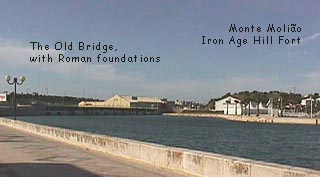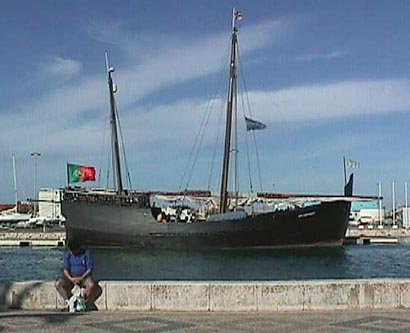

What to Do--Where to Stay--What to Buy--Day Trips
Aerial Photos -- A Visit to
the Algarve 1572 -- Other Places -- Map
-- Home
 |
The bridge to Meia Praia, looking from the Avenida dos Descobrementos (The
Avenue of the Discoveries), opposite the Marina, across the River Bensafrim. Monte Molião is possibly the site where Quintus Setorius, the noble Roman rebel, helped the Lusitanians defend Lacobriga against the Roman army of Metellus Piso. |
The Roman Lacobriga was the first town to occupy
this position, at the mouth of the Bensafrim River.
The remains of the Roman period lie beneath the oldest part of the city. The foundations
of the bridge leading over the river to Meia Praia are also Roman. Here, as on much of the
Southwest coast, the principal industry was that of salting fish, and making the special
Roman condiment of Garum. The Garum of Portugal was so highly prized that it was shipped
direct to Rome.
Roman remains have been found throughout the Lagos area and at Praia da Luz, Boca
do Rio and at Martinhal, on the north shore of the Bay of Sagres.
The Moors were the next to influence the town. They
called it Zawiya. At this time Chelbs, modern day Silves, was the capital of the province
known as Al Gharb, meaning The West.
The oldest ‘purpose built’ church in the Algarve, rather than an adapted Roman
temple, is that of St. John the Baptist. This was constructed by the Christians of Lagos,
who were given permission to do so by the Wali of the town around 1174 A.D., as long as
the building was outside the town limits. Today this little church is still outside the
main area of the town, by the roundabout on the road north to Lisbon and east to
Portimão.
| Ermida de São João Batista (Hermitage of St. John the Baptist) The inscription above
the door states that the church was founded in 1147, which is considered to be correct.
This makes it the oldest 'purpose-built' church in the Algarve. |
|
|
After the knights of the Re-Conquest had regained
the Algarve in the 13th Century, nothing much of note happened here, until the
end of the 14th Century. The Bay of Lagos became a gathering point for the
fleets coming round Cape St. Vincent from
Lisbon, before leaving to fight the Moors at Cueta, in Africa.
The Infante Dom Henrique, the third surviving son of King João I of Portugal, and his
English wife Philippa of Lancaster, was one of the Princes on board these ships. Later
Prince Henry was given grants of land at Sagres, Raposeira and Lagos.
The harbour at Lagos was most suitable for the construction of the Caravels; the lateen
sailed ships which were to take the Portuguese on their fantastic voyages of discovery.
The merchants put their money into Prince Henry’s projects, and many a young man from
the district became a navigator or pilot. The town entered a period of great prosperity.
 |
The"Boa Esperança" Built in Vila do Conde in
1989-1990, for the Portuguese sail Training Association, this replica of a 15th century
Caravel has been visiting Lagos, April 1999. |
All this was to finish at the death of Henry the Navigator. His body rested for a short while at the old parish church of Lagos, before it was transported north to Batalha. There no longer being a member of the Royal Family with any great interest in the Algarve, many of the established trading houses were moved to the capital, Lisbon.
At the end of the 16th Century, the Boy-King Sebastian elevated the town to the rank of city. This young man, in his late teens, fancied himself as a warrior, and had gathered an army to invade Morocco. The fleet assembled at Lagos, and the troops mustered in front of the castle, where tradition says that they were addressed by the young King from the Manuelin window in the walls of the Governor’s Palace. It was an ill-fated expedition. Many fell in the battle of Alcacer-Quibir, and among them the King, who had no heirs, except his ageing Uncle Henry, the Cardinal.
King Philip of Spain became the King of Portugal, by right of both blood and conquest. During this time he entered into war with England, and Lisbon was one of the muster points for the Spanish Armada. This made the Algarve a target for Sir Francis Drake, who would harry the coast on his way to and from his inspections of the Spanish fleet lying in Cadiz. On one such raid Sir Francis attacked Lagos, but the citizens put up such a good defence that he left empty handed and made his way to Sagres. Here resistance was much weaker, and he set fire to the town and captured the fort, taking the cannon for his ships.
After this, the Algarve coast was much
at the mercy of several groups of pirates, such as the English and Dutch freebooters, and
the most feared of all, the slave-taking Corsairs. To help in the defence of the land a
series of small forts were constructed all along the coast from Castro Marim to Cape St. Vincent and on up towards Lisbon.
The "Fortelezas" around this south-west peninsula were at:
Meia Praia, Pau da Bandeira, Pinhão, Ponte de Piedade and Porto de Mós at Lagos, Praia da Luz, Burgau, Almádena, Figueira,
Zavial, Baleeira,
just south of Sagres fishing harbour, Sagres itself, Beliche
and then on up the west coast, Carrapateira.
The town walls of Lagos were repaired and reinforced, for the last time in earnest.
| çThe Western Bastion of the Town Walls The Western arch, inscribed 1932. è |
The Great Earthquake, on November 1st,
1755, caused almost total destruction, and many buildings, such as the parish church of
Santa Maria da Graça, within the oldest town walls, were never to rise again. Others,
such as the church of St. António, were badly damaged, but still retain some of their
earlier features.
As the death of Prince Henry had removed the commercial opportunities of the town, the
Earthquake of 1755 removed the political importance of the city. With his castle and all
the principal buildings in ruins, the Governor of the Algarve moved to Tavira.
| Nets on the quayside in Lagos fishing port. |
Fishing was the background industry of this once highly prosperous town. In the Middle Ages whales were brought ashore at many points along the coast, as is indicated by the place-name Baleeira, derived from the Portuguese for whale. As whaling declined, the fishermen’s attention turned to tuna. These were caught in great funnel nets, which were set up offshore along the routes that the fish took in their migrations to the Mediterranean. The nets were stored in a large warehouse termed Armação. As the tuna became scarce and their runs made further out to sea, the next harvest to be exploited was that of the sardine. In the late 19th century there were four sardine canning factories in the vicinity. The chimney-stacks of these remain, to provide nesting platforms for the White storks.
Cork, figs and almonds were the traded produce of the local farms.
Looking to the year 2000?
|
|
This modern work of Art was inaugurated |
Top of Page -- Map -- Home